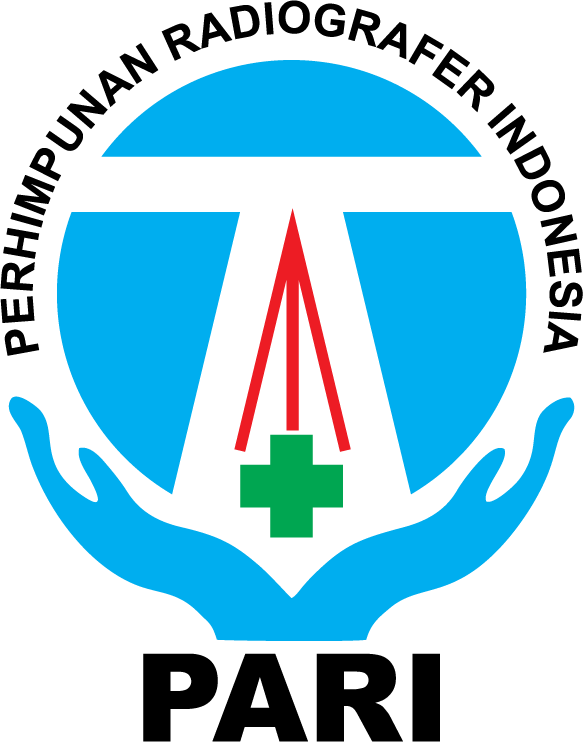RADIATION DOSE REDUCTION ON BREAST AREA BY USING LEAD APRON: A PRE-EXPERIMENTAL STUDY IN ABDOMINAL CT
Abstract
Backgroud: Previous researches show that the use of out of plane shielding can reduce the radiation dose received by radiosensitive organs around the scan area on CT scan. There is a special shielding designed for CT scans, but currently the type of shielding available in almost all radiology installations is the lead apron. This study aims to determine the dose received by the breast area on CT abdominal scan without shielding and its reduction by giving lead apron shielding on 1800 and 3600.
Methods:This is quantitative research with a pre-experimental design. Abdominal CT scan was performed on a whole body CT phantom whose characteristics are close to human body tissue. The radiation dose received by the breast area was measured by Termoluminisence-dosemeter (TLD). TLD’s were placedon the same points. Scanning was performed using Siemens Somaris/5 Syngo, repeated in three conditions: without shielding, lead apron shielded (equivalent to 5 mm Pb) by 1800 and 3600. The rouitne protocol was used (120 kv and 200 mA) Data was analyzed by Paired t-test to determine the difference in radiation dose received and descriptive analysis for know the level of reduction.
Results:The radiation dose received by the breast area without shielding, with shielding 1800, and with shielding 3600 were respectively 0.653 mSv, 0.367 mSv, and 0.242 mSv. There were significant differences in the dose received by the breast area (p value <0.05) by using shielding. Compared to unshieldied condition, there was a decrease of 43.95% when shielded 1800, and a decrease of 62.94% when shielded 1800.
Conclusion:Lead apron is effective for reducing radiation dose on breast in abdominal CT. 3600 shielding provides higher reduction than 3600 shielding, so it can be considered to be applied in clinical procedure.
Keywords
Full Text:
PDFReferences
AAPM. 2012. AAPM Statement on Bismuth Shielding for CT. https://www.asrt.org/main/news-research/radiologic-technology-news/2012/04/02/AAPM-Statement-on-Bismuth-Shielding-for-CT
Abuzaid MM, Elshami W, Haneef C, dan Alyafei S. 2017. Thyroid Shielding During Brain CT Scan: Dose Reduction and Image Quality Evaluation. Imaging Med. edisi 9, vol 3.
BEIR. 2005. BEIR Report VII: Health Risks from Exposure to Low Levels of Ionizing Radiation. National Academies Press: Washington. www.nap.edu.
Brnic Z, Vekic B, Hebrang A, dan Anic P. 2003. Effiacy of Breast Shielding During CT of The Head. V.simpozij HDZZ Stubicke Toplice.
Hiswara, Eri. 2015. Buku Pintar Proteksi dan Keselamatan Radiasi di Rumah Sakit. Jakarta: BATAN Press.
Klasic B, Brni Z, Kneževi Ž, Plascak J, Vidjak V, Zagreb HR. 2013. Efficacy and feasibility of out-of-plane patient shielding during CT scanning. Electronic Presentation Online System in ECR: European Society of Radiologist.
Maharani AA. 2014. Pengukuran Dosis Radiasi Organ Sensitif pada Pemeriksaan CT Scan Abdomen dengan Fantom Rado. Jakarta: FMIPA UI.
Ngaile JE, Uiso CBS, dan Msaki P, Kazema R. 2008. Use of Lead Shields for Radiation Protection of Superficial Organs in Patients Undergoing Head CT Examinations. Radiat Prot Dosimetry 2008:130.
Sudheendra D. 2006. Diagnostic and Interventional CT Shielding: A Dramatic Drcrease in Scattered Radiation for Patients. Prosiding pada SIR Annual Scientific Meeting ke 31 di Canada.
DOI: https://doi.org/10.31983/jimed.v5i1.3987
Article Metrics
Refbacks
- There are currently no refbacks.
JURNAL IMEJING DIAGNOSTIK by http://ejournal.poltekkes-smg.ac.id/ojs/index.php/jimed is licensed under a Creative Commons Attribution-ShareAlike 4.0 International License.

.png)
.png)
.png)
.png)
.png)
.png)
.png)











